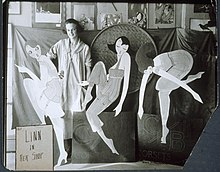Standee
This article needs additional citations for verification. (May 2014) |

A standee is an American term for a large self-standing display promoting a movie, product or event, or point-of-sale advertising, often in the form of a life-size cut-out figure. They are typically made of foam-board, and may range from large self-standing posters to elaborate three-dimensional display devices with moving parts and lights.
Standees are typically displayed in theater lobbies or music stores in advance of film or music releases.
In the movie business, the more bookings a theater makes in advance for a given film, the more likely it is to place standees in its lobby because of self-interest to spur consumer interest in its future screen offerings. Standees are also called lobby stands in the film industry.
In recent years,[when?] theaters increasingly look to on-site advertising from non-movie companies as a revenue source, which creates occasional friction with film distributors; when standees for Paramount's Lara Croft Tomb Raider: The Cradle of Life incorporated a promotion for the 2003 movie's tie-in promotion with Jeep automobiles, large theater circuit Regal Cinemas sought payments from Jeep for the exposure in its theaters. Paramount reportedly shifted bookings from 47 Regal theaters to other cinemas that erected the Tomb Raider/Jeep standees without payments from Jeep.[1]
While standees have previously been available only in large quantities,[citation needed] recent advances in digital photography and print-on-demand technology have made them widely available to the public. Several companies now offer these items as party decorations, gag gifts and memorial items for the deceased. Standees can now be purchased as one-off custom products, bringing them to the average consumer as well as large corporations and venues.
History[]

While mannequins have been used in advertising for fashion, the capacity to cheaply print large-sized images, especially in colour, has provided an eye-catching alternative for the advertising of other products.[2]
The production of such figurines evidently stretches from early in the 20th century; they appear in a photograph dating from 1917-1925 by Jessie Tarbox Beals (see right), and others including a Santa Claus, appear lining the walls in Walker Evans' 1936 documentary image Coal Miner's House, Scott's Run, West Virginia. The term "standee" has been in use at least since 1933, when it appeared in the Motion Picture Herald.[3][4]
Especially well-known and effective internationally was the series of figurines created for a 1947 L'Oréal campaign by French advertising photographer Lucien Lorelle for which the model known only as 'Suzy B', became "Miss Ambre Solaire"; a life-size cut-out of her bikini-clad and tanned body stood at the entrance of the shops and pharmacies of French seaside resorts until the end of the 50s to advertise L'Oréal's sun tan lotion formulated in 1935.[5]

Since 2020 due to the COVID-19 pandemic, which has forced many sporting events to have reduced or no public attendance, some venues have employed standees to fill seats. Some teams have allowed members of the public to submit their photos to appear on standees in exchange for a charitable donation.[6][7] Some teams have used standees of fictional characters in this manner as well, such as the Denver Broncos (which filled a portion of the stands with South Park characters as a promotion for the series—which was created by Colorado natives, and set in a fictitious town in the state),[8] and the Detroit Lions (which used standees of Animal Crossing villagers and characters during one game, as a follow-up to an Animal Crossing-themed video used to unveil their 2020 schedule).[9]
References[]
- ^ Marich, Robert. Marketing To Moviegoers: Third Edition (2013). SIU Press books. p 168
- ^ Chaminade, J (1969), 700 mots courants de la publicité et de l'imprimerie : définitions, lexique francais-anglais-allemand, Eyrolles
- ^ "Motion Picture Herald". Quigley Publishing Company. April 6, 1935 – via Google Books.
- ^ "Motion Picture Herald". Quigley Publishing Company. April 6, 1933 – via Google Books.
- ^ The Publishers Weekly, Volume 161, 1952, p.990. R.R. Bowker Company, Publishers' Board of Trade (U.S.), Book Trade Association of Philadelphia, Am. Book Trade Association, American Book Trade Union. Pub. F. Leypoldt
- ^ "The cardboard cutout revolution is real". MLB.com. Retrieved 2021-02-17.
- ^ "Borussia Mönchengladbach fans' cardboard cut-outs raise €40,000 for charity". bundesliga.com - the official Bundesliga website. Retrieved 2021-02-17.
- ^ "'South Park' To Once Again Pack Denver Broncos Stadium With New Character Cutouts". The Hollywood Reporter. 2020-10-23. Retrieved 2021-02-17.
- ^ "Animal Crossing Characters Fill Empty Seats At Detroit Lions Game". ScreenRant. 2020-11-02. Retrieved 2021-02-17.
External links[]
| Wikimedia Commons has media related to Standees. |
- Film advertising material
- Advertising
- Marketing techniques
- Film terminology stubs